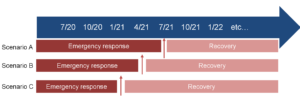
Scenario Planning in the time of COVID-19
The COVID-19 crisis is affecting the arts and culture sector in an unprecedented way. Amidst an uncertain and seemingly ever-shifting environment, organizations must continue to respond to immediate challenges presented by the crisis while attempting to understand the potential implications of the crisis for next month, next season, and beyond. As part of our Re-launch online learning series, OC welcomed Susan Nelson and Bailey Hoar of TDC to outline how to develop scenarios that sit at the intersection of public health, audience demand, and programming; and to share how continued scenario planning can support organizations’ long-term recovery and repositioning.
This slide deck gives a framework that leaders of cultural organizations can follow as they map:
- What’s possible during the current “emergency response” phase,
- Options through a “slow and bumpy recovery”,
- What rebuilding and repositioning could look like.
At each of these stages public health restrictions, audience demand and attitudes, and programming considerations need to be taken into account. To maintain flexibility and responsiveness in a fluid situation, Susan and Bailey recommend planning in rolling quarterly cycles as opposed to annual or multi-year plans.
A recording of this session is available here.
It’s challenging to add anything to the clear framework that Susan and Bailey have shared; still, two key points in their presentation bear emphasis:
 Consider: your mission is more important than the traditional ways in which you have been delivering it. The main activities of our orchestras have always been bringing large groups of people together for live performance. But orchestras’ missions are potentially more profound than the tactics used to achieve them. If your mission commits you to delivering community service and community value, can you reimagine what that engagement might look like? Rather than moulding existing activities to fit health restrictions, what would it look like if you exploded your orchestra’s seasons entirely? What might a season of smaller-scale community activities look like? How might you achieve mission-consistent results in a different way?
Consider: your mission is more important than the traditional ways in which you have been delivering it. The main activities of our orchestras have always been bringing large groups of people together for live performance. But orchestras’ missions are potentially more profound than the tactics used to achieve them. If your mission commits you to delivering community service and community value, can you reimagine what that engagement might look like? Rather than moulding existing activities to fit health restrictions, what would it look like if you exploded your orchestra’s seasons entirely? What might a season of smaller-scale community activities look like? How might you achieve mission-consistent results in a different way?
 Plan for the worst, but be ready for the best. Susan and Bailey emphasized the importance of being agile in planning. They suggested starting with the worst case scenario and building plans up from there. As mentioned before, they suggest planning in rolling quarterly cycles, reassessing upcoming cycles as more information becomes available to you.
Plan for the worst, but be ready for the best. Susan and Bailey emphasized the importance of being agile in planning. They suggested starting with the worst case scenario and building plans up from there. As mentioned before, they suggest planning in rolling quarterly cycles, reassessing upcoming cycles as more information becomes available to you.
We welcome your responses to this framework – and we’re very grateful to Susan Nelson and Bailey Hoar for sharing their expertise with us.
